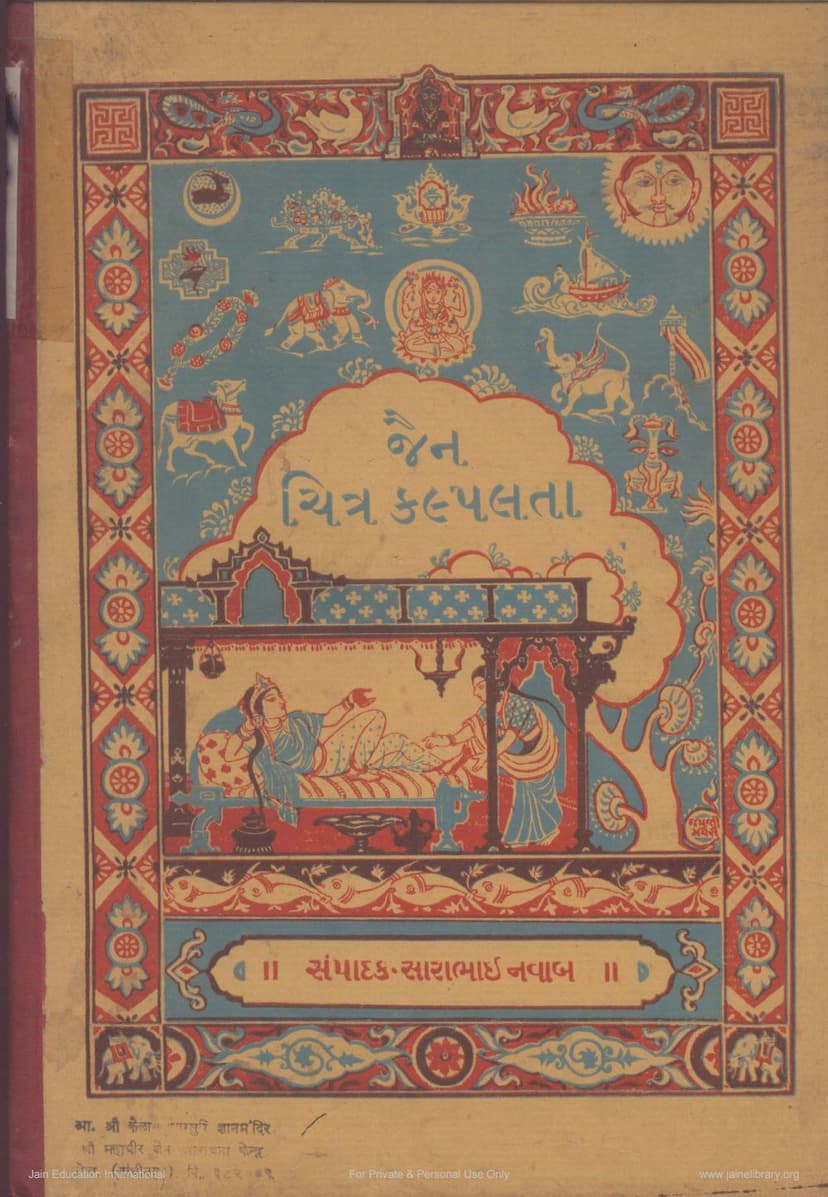Jain Chitra Kalplata
Added to library: September 1, 2025

Summary
Here's a comprehensive summary of the Jain text "Jain Chitra Kalplata," based on the provided pages:
Title: Jain Chitra Kalplata (જૈન ચિત્રકલ્પલતા) Author/Editor/Publisher: Sarabhai Manilal Nawab (સારાભાઈ મણિલાલ નવાબ) Publisher: Sarabhai Manilal Nawab Publication Year: Samvat 1996 (1940 CE) Price: Eight Rupees
Overview:
"Jain Chitra Kalplata" is a significant publication dedicated to showcasing and analyzing Jain art, particularly miniature paintings from Gujarat, spanning from the 11th to the 20th century CE. It is presented as the eleventh flower in the series "Jain Prachin Sahityadwar Granthavali" (Collection of Ancient Jain Literature).
The book is a compilation of selected color and monochrome illustrations from the author's earlier, more extensive work, "Jain Chitra Kalpadruma." The motivation behind this abridged version was the realization that the original book, priced at twenty-five rupees, was inaccessible to the common reader. "Jain Chitra Kalplata" aims to democratize access to these valuable Jain artistic treasures.
Content and Themes:
The book meticulously presents and discusses numerous Jain paintings, focusing on their artistic and iconographic significance. Key areas covered include:
- Scope of Jain Art: The text emphasizes that Jain painting, as represented in this book, is primarily confined to Svetambara manuscript painting. It traces the evolution of this art form, starting from the Early Western Indian style (also known as Gujarat or Jain style) and extending to later styles influenced by the Rajput-Mughal complex.
- Historical Significance: The author highlights that Jain manuscript illustrations are a crucial source for understanding Indian miniature painting, especially during the medieval period when palm leaves were the primary medium for manuscripts. The text notes that, based on available documents, only Svetambara Jains extensively illustrated their manuscripts during this period.
- Artistic Analysis: The book delves into the aesthetic qualities and techniques of these paintings. It discusses the "grammar of color and line" (રંગ-રેખાની ભાષા) and how artists conveyed emotions and narratives through their compositions. It also touches upon the importance of understanding the "time" (સમય) of the artist – their context, patrons, and objectives.
- Evolution of Styles: The forewords and introductory notes, by scholars like W. Norman Brown and Hirananda Sastri, provide valuable context about the development of Jain painting. They highlight the transition from palm-leaf manuscripts to paper, the distinct characteristics of the Early Western Indian style, and the integration of Persian elements in some manuscripts.
- Specific Painting Examples: The book features a rich collection of paintings with detailed descriptions and analyses. These include depictions of:
- Deities and Religious Figures: Goddesses like Saraswati and Ambika, Vidyadevis such as Apratimachakra (Chakreshwari) and Purudatta (Naradatta), Yakshas like Brahma Shanti, and prominent Jain figures like Tirthankaras (Rishabhdev, Parshvanath, Mahavir, Neminath) and Acharyas like Hemchandrasuri.
- Key Life Events (Kalyanakas) of Tirthankaras: The paintings illustrate significant moments like conception (Chyavan), birth (Janma), renunciation (Diksha), omniscience (Kevalya), and liberation (Nirvana). The text explains the conventional artistic representations of these events.
- Historical and Literary Narratives: Illustrations depict scenes from Jain literature, such as the stories of Bharat and Bahubali, Chandakaushika's transformation, and the teaching of Hemchandrasuri to King Jayasimhadeva.
- Ornamental Art: The book also showcases intricate marginal designs, floral patterns, and decorative elements found in Jain manuscripts, particularly from the Kalpasutra.
- Social and Cultural Insights: The paintings offer glimpses into the attire, customs, architecture, and daily life of people during the medieval period in Gujarat and surrounding regions. The text notes how these illustrations can reveal aspects of social practices, like the introduction of veiling after the Mughal period.
- Artistic Conventions and Interpretations: The text explores specific artistic conventions, such as the depiction of eyes, the use of colors, and the representation of movement and posture in a static medium. It also addresses potential misinterpretations of Jain art by those unfamiliar with its underlying philosophy and artistic intent. The author, Sarabhai Manilal Nawab, offers his own interpretations and analyses, drawing on his extensive research.
- Preservation and Appreciation: The book serves as a call to action for Jains to recognize and preserve the rich artistic heritage housed in their manuscript collections. It aims to foster appreciation for the skill, devotion, and cultural significance of these ancient artworks.
Key Contributors and References:
The book benefits from the insights of scholars like W. Norman Brown and Hirananda Sastri, whose forewords provide an external academic perspective. The author also frequently references and acknowledges other scholars and previous works in the field of Indian art and Jain literature.
Overall Significance:
"Jain Chitra Kalplata" is a valuable resource for anyone interested in Indian art history, Jainism, and the cultural heritage of Gujarat. By making these exquisite Jain paintings accessible, Sarabhai Manilal Nawab has made a significant contribution to the study and appreciation of this vibrant art form. The book not only preserves and showcases these visual narratives but also provides a framework for understanding their artistic evolution, cultural context, and devotional significance within the Jain tradition.